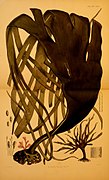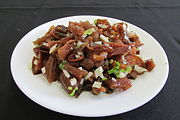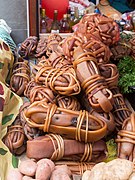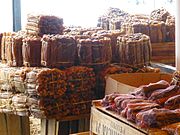| Durvillaea antarctica | |
|---|---|

| |
| Durvillea antarctica. Washed up on Sandfly Bay, Otago, New Zealand | |
| Scientific classification | |
| Domain: | Eukaryota |
| Clade: | Diaphoretickes |
| Clade: | SAR |
| Clade: | Stramenopiles |
| Phylum: | Gyrista |
| Subphylum: | Ochrophytina |
| Class: | Phaeophyceae |
| Order: | Fucales |
| Family: | Durvillaeaceae |
| Genus: | Durvillaea |
| Species: | D. antarctica |
| Binomial name | |
| Durvillaea antarctica (Chamisso) Hariot | |
Durvillaea antarctica, also known as cochayuyo and rimurapa, is a large, robust species of southern bull kelp found on the coasts of Chile, southern New Zealand, and Macquarie Island. D. antarctica, an alga, does not have air bladders, but floats due to a unique honeycomb structure within the alga's blades, which also helps the kelp avoid being damaged by the strong waves.
Taxonomy

The species was first described in 1822, as Fucus antarcticus, and revised in 1892 as Durvillaea antarctica. The genus name Durvillaea was given in memory of the French explorer Jules Dumont d'Urville, while the Latin derived epithet refers to antarctic.
In 2012, a taxonomic revision led to the recognition of a new species, Durvillaea poha, based on genetic, morphological and ecological evidence, which was previously recognised as the 'cape' lineage of Durvillaea antarctica. D. poha is the only other species in the genus to share the honeycombed structure and buoyancy of D. antarctica. D. poha occurs only in southern New Zealand and on subantarctic islands (including Snares and Auckland Islands), whereas D. antarctica has a wider distribution, and is found around New Zealand, Chile and other subantarctic islands. In southern New Zealand, D. poha and D. antarctica can be found growing together, although D. poha normally grows higher up or further back on the rock platforms, or in more sheltered bays, where wave force is weaker. D. poha generally has wider fronds than D. antarctica, and can appear more 'orange' across the frond area. Mitochondrial introgression has been observed between the two species, where some plants in Wellington exhibited the nuclear DNA of D. poha but also mitochondrial DNA belonging to D. antarctica.
Further diversity, with additional unclassified lineages have been identified within the species.
|
Description
The blades of Durvillaea antarctica are green to golden brown with a leathery texture. The honeycomb structure of the blade gives strength and buoyancy. This novel structure is thought to be responsible for the wide distribution of this genus, as the kelp is able to float when its holdfast fails. It can colonise other coastlines in this manner, and has been shown to carry communities of invertebrates across vast ocean distances from one shore to another. Specimens of D. antarctica have been found to float for up to 210 days, during which time high wind speeds transport kelp rafts up to 10,000 km. Environmental factors such as temperature, solar radiation and surface winds (all of which vary with latitude) affect buoyancy of rafts and their rate of travel. Rafts of D. antarctica are more likely to disperse offshore if plants detach during outgoing tides during autumn and winter. It is thought that this 'rafting' with Durvillaea antarctica and other floating seaweeds allowed a wide range of species to recolonise sub-Antarctic shores scoured clean by ice during the last Ice Age.
The holdfast of D. antarctica is large and is very difficult to remove. D. antarctica has to resist forces equivalent to 1100 km/h on land. The holdfast failing is usually the result of worms and molluscs which feed on the tissue because of the sheltered habitat it creates. It is also common for its host rock to be broken off without the holdfast losing its grip, with this contributing significantly to erosion in some areas. Recruitment rates of this species is very low, therefore the ecological impact of harvesting this species is too great.
Morphology of D. antarctica-
 Cross-section revealing the honeycomb structure of blades
Cross-section revealing the honeycomb structure of blades
-
Another cross-section
-
The long, narrow and dark blades of D. antarctica
-
 Illustration of D. harveyi, now D. antarctica, by Walter Hood Fitch for J. D. Hooker's Flora Antarctica, 1843–1859
Illustration of D. harveyi, now D. antarctica, by Walter Hood Fitch for J. D. Hooker's Flora Antarctica, 1843–1859
Life cycle
Durvillaea antarctica reproduces sexually by producing egg and sperm that are released into the water. Eggs and sperm are produced on specific sites of the frond. A large individual can produce 100 million eggs in twelve hours. The season when reproduction occurs varies with location, but is generally during winter months. Eggs are small and disperse over short distances, and they generally require calm or moderate wave action in order to settle and successfully attach to substrates.
Distribution

Durvillaea antarctica has a circumpolar distribution between the latitudes of 29°S and 55°S, found in Chile, southern New Zealand, and Macquarie Island. The type locality is Cape Horn, Chile.
It is found on exposed shores, especially in the northern parts of its range, and attaches itself with a strong holdfast.
Epifauna, parasites and rafting
See also: Durvillaea
Holdfasts of D. antarctica are often inhabited by a diverse array of epifaunal invertebrates, many of which burrow into and graze on the kelp. In New Zealand, epifaunal species include the crustaceans Parawaldeckia kidderi, P. karaka and Limnoria stephenseni, and the molluscs Cantharidus roseus, Onchidella marginata, Onithochiton neglectus, and Sypharochiton sinclairi. The intertidal spider Desis marina also inhabits the holdfasts of D. antarctica.
Plants of D. antarctica can detach from substrates, particularly during storms. The kelp floats as a raft and can travel vast distances at sea, driven by ocean currents. Kelp-associated invertebrates can be transported inside of drifting holdfasts, potentially leading to long-distance dispersal and a significant impact upon the population genetic structure of those species.
Fronds of D. antarctica can be infected by an endophytic, phaeophycean algal parasite Herpodiscus durvillaeae (Lindauer) G. R. South. Fronds can also be infected Maullinia, a genus of intracellular, protistan parasites. Based on genetic evidence, both H. durvillaeae and Maullinia have likely been dispersed across the Southern Hemisphere via rafting bull kelp.
Human use

Chilean culture
Use in cuisine
Stems and holdfasts of D. antarctica and D. incurvata are harvested from the coast of Chile and is used in Chilean cuisine for various recipes, including salads and stews. In Quechua the species is called: cochayuyo (cocha: lake, and yuyo: weed), and hulte. The Mapuche indigenous people refer to it as collofe or kollof.
Expression
The expression remojar el cochayuyo (literally: to soak the cochayuyo) is used in Chilean Spanish to refer to sexual intercourse. The expression derives from the fact that harvested D. antarctica is preserved by being sun-dried and then softened by soaking in a dish of water.
Cochayuyo cuisineMāori culture
Along with D. poha, blades of D. antarctica are used to make traditional pōhā bags, which are used to carry and store food and fresh water, to propagate live shellfish, and to make clothing and equipment for sports. Pōhā are especially associated with Ngāi Tahu and are often used to carry and store muttonbird (tītī) chicks. The species is called rimurapa in Māori.
References
- ^ "rimurapa". māoridictionary.co.nz. Retrieved 21 November 2019.
- ^ Smith, J.M.B. and Bayliss-Smith, T.P. (1998). Kelp-plucking: coastal erosion facilitated by bull-kelp Durvillaea antarctica at subantarctic Macquarie Island, Antarctic Science 10 (4), 431–438. doi:10.1017/S0954102098000522.
- ^ Fraser, Ceridwen I.; Spencer, Hamish G.; Waters, Jonathan M. (2012). "Durvillaea poha sp. nov. (Fucales, Phaeophyceae): a buoyant southern bull-kelp species endemic to New Zealand". Phycologia. 51 (2): 151–156. Bibcode:2012Phyco..51..151F. doi:10.2216/11-47.1. S2CID 86386681.
- ^ Parvizi, Elahe; Craw, Dave; Waters, Jonathan M. (2019). "Kelp DNA records late Holocene paleoseismic uplift of coastline, southeastern New Zealand". Earth and Planetary Science Letters. 520: 18–25. Bibcode:2019E&PSL.520...18P. doi:10.1016/j.epsl.2019.05.034. S2CID 189974346.
- ^ Fraser, Ceridwen I.; Velásquez, Marcel; Nelson, Wendy A.; Macaya, Erasmo C.A.; Hay, Cameron (2019). "The biogeographic importance of buoyancy in macroalgae: a case study of the southern bull-kelp genus Durvillaea (Phaeophyceae), including descriptions of two new species". Journal of Phycology. 56 (1): 23–36. doi:10.1111/jpy.12939. PMID 31642057.
- ^ W. A., Nelson (2013). New Zealand seaweeds : an illustrated guide. Wellington, New Zealand: Te Papa Press. p. 66. ISBN 9780987668813. OCLC 841897290.
- ^ Maggy Wassilieff. Seaweed - Bull kelp’s honeycombed structure, Te Ara - the Encyclopedia of New Zealand, Ministry of Culture and Heritage. Updated 2 March 2009. Retrieved 9 March 2010.
- Choris, L. (1822). Voyage pittoresque autour du monde. Part I. pp. vi + 17, 12 plates. Paris
- Hariot, P. (1892). Complément à la flore algologique de la Terre de Feu. Notarisia 7: 1427-1435.
- Guiry, M.D.; Guiry, G.M. "Durvillaea antarctica". AlgaeBase. University of Galway.
- Fraser, Ceridwen I.; Hay, Cameron H.; Spencer, Hamish G.; Waters, Jonathan M. (2009). "Genetic and morphological analyses of the southern bull kelp Durvillaea antarctica (Phaeophyceae: Durvillaeales) in New Zealand reveal cryptic species". Journal of Phycology. 45 (2): 436–443. Bibcode:2009JPcgy..45..436F. doi:10.1111/j.1529-8817.2009.00658.x. PMID 27033822. S2CID 18309093.
- ^ Fraser, C.I.; Winter, D.J.; Spencer, H.G.; Waters, J.M. (2010). "Multigene phylogeny of the southern bull-kelp genus Durvillaea (Phaeophyceae: Fucales)". Molecular Phylogenetics and Evolution. 57 (3): 1301–11. Bibcode:2010MolPE..57.1301F. doi:10.1016/j.ympev.2010.10.011. PMID 20971197.
- Vaux, Felix; Craw, Dave; Fraser, Ceridwen I.; Waters, Jonathan M. (2021). "Northward range extension for Durvillaea poha bull kelp: Response to tectonic disturbance?". Journal of Phycology. 57 (5): 1411–1418. Bibcode:2021JPcgy..57.1411V. doi:10.1111/jpy.13179. PMID 33942304.
- Fraser CI, Nikula R & Waters JM (2011) Oceanic rafting of a coastal community. Proceedings of the Royal Society, B, 278:649-655.
- ^ Tala, Fadia; López, Boris A.; Velásquez, Marcel; Jeldres, Ricardo; Macaya, Erasmo C.; Mansilla, Andrés; Ojeda, Jaime; Thiel, Martin (2019). "Long-term persistence of the floating bull kelp Durvillaea antarctica from the South-East Pacific: Potential contribution to local and transoceanic connectivity". Marine Environmental Research. 149: 67–79. Bibcode:2019MarER.149...67T. doi:10.1016/j.marenvres.2019.05.013. PMID 31154063. S2CID 173993590.
- Hawes, Nicola A.; Taylor, David I.; Schiel, David R. (2019). "Transport of drifting fucoid algae: Nearshore transport and potential for long distance dispersal". Journal of Experimental Marine Biology and Ecology. 490: 634–41. doi:10.1016/j.jembe.2017.02.001.
- Fraser CI, Nikula R, Spencer HG & Waters JM (2009) Kelp genes reveal effects of subantarctic sea ice during the Last Glacial Maximum. Proceedings of the National Academy of Sciences, USA, 106:3249-3253.
- Hurd, C (2003). The Living Reef. Nelson, New Zealand: Craig Potton Publishing.
- ^ Bradstock, M (1989). Between the Tides. New Zealand: David Bateman Limited.
- ^ Vaux, Felix; Parvizi, Elahe; Duffy, Grant A.; Dutoit, Ludovic; Craw, Dave; Waters, Jonathan M.; Fraser, Ceridwen I. (2024). "First genomic snapshots of recolonising lineages following a devastating earthquake". Ecography: e07117. doi:10.1111/ecog.07117.
- Taylor, David; Delaux, Sebastien; Stevens, Craig; Nokes, Roger; Schiel, David (2009). "Settlement rates of macroalgal algal propagules: Cross-species comparisons in a turbulent environment". Limnology and Oceanography. 55 (1): 66–76. doi:10.4319/lo.2010.55.1.0066.
- Parvizi, Elahe; Fraser, Ceridwen I.; Dutoit, Ludovic; Craw, Dave; Waters, Jonathan M. (2020). "The genomic footprint of coastal earthquake uplift". Proceedings of the Royal Society B. 287 (1930): 20200712. doi:10.1098/rspb.2020.0712. PMC 7423469. PMID 32635859.
- Vaux, Felix; Parvizi, Elahe; Craw, Dave; Fraser, Ceridwen I.; Waters, Jonathan M. (2022). "Parallel recolonisations generate distinct genomic sectors in kelp following high magnitude earthquake disturbance?". Molecular Ecology. 31 (18): 4818–4831. Bibcode:2022MolEc..31.4818V. doi:10.1111/mec.16535. PMC 9540901. PMID 35582778.
- Vaux, Felix; Fraser, Ceridwen I.; Craw, Dave; Read, Stephen; Waters, Jonathan M. (2023). "Integrating kelp genomic analyses and geological data to reveal ancient earthquake impacts". Journal of the Royal Society Interface. 20 (202). doi:10.1098/rsif.2023.0105. PMC 10189309. PMID 37194268.
- ^ Parvizi, Elahe; Dutoit, Ludovic; Fraser, Ceridwen I.; Craw, Dave; Waters, Jonathan M. (2022). "Concordant phylogeographic responses to large-scale coastal disturbance in intertidal macroalgae and their epibiota". Molecular Ecology. 31 (2): 646–657. Bibcode:2022MolEc..31..646P. doi:10.1111/mec.16245. PMID 34695264. S2CID 239888553.
- ^ Cumming, Rebecca A.; Nikula, Raisa; Spencer, Hamish G.; Waters, Jonathan M. (2014). "Transoceanic genetic similarities of kelp-associated sea slug populations: long-distance dispersal via rafting?". Journal of Biogeography. 41 (12): 2357–2370. Bibcode:2014JBiog..41.2357C. doi:10.1111/jbi.12376. S2CID 84574097.
- ^ Nikula, Raisa; Fraser, Ceridwen I.; Spencer, Hamish G.; Waters, Jonathan M. (2010). "Circumpolar dispersal by rafting in two subantarctic kelp-dwelling crustaceans". Marine Ecology Progress Series. 405: 221–230. Bibcode:2010MEPS..405..221N. doi:10.3354/meps08523.
- ^ Nikula, Raisa; Spencer, Hamish G.; Waters, Jonathan M. (2013). "Passive rafting is a powerful driver of transoceanic gene flow". Biology Letters. 9 (1): 20120821. doi:10.1098/rsbl.2012.0821. PMC 3565489. PMID 23134782.
- ^ Waters, Jonathan M.; King, Tania M.; Fraser, Ceridwen I.; Craw, Dave (2018). "An integrated ecological, genetic and geological assessment of long-distance dispersal by invertebrates on kelp rafts". Frontiers of Biogeography. 10 (3/4): e40888. doi:10.21425/F5FBG40888.
- McLay, C. L.; Hayward, T. L. (1987-01-01). "Population structure and use of Durvillaea antarctica holdfasts by the intertidal spider Desis marina (Araneae: Desidae)". New Zealand Journal of Zoology. 14 (1): 29–42. doi:10.1080/03014223.1987.10422679. ISSN 0301-4223.
- Vink, C., McQuillan, B., Simpson, A., & Correa-Garhwal, S. (2017). The marine spider, Desis marina (Araneae: Desidae): new observations and localities. The Weta, 51, 71-79. Retrieved from http://publications.ento.org.nz/index.php/weta/article/view/167 Archived 2019-12-20 at the Wayback Machine
- Heesch, Svenja; Peters, Akira F.; Broom, Judy E.; Hurd, Catriona L. (2008). "Affiliation of the parasite Herpodiscus durvillaeae (Phaeophyceae) with the Sphacelariales based on DNA sequence comparisons and morphological observations". European Journal of Phycology. 43 (3): 283–295. Bibcode:2008EJPhy..43..283H. doi:10.1080/09670260801911157.
- ^ Fraser, Ceridwen I.; Waters, Jonathan M. (2013). "Algal parasite Herpodiscus durvillaea (Phaeophyceae: Sphacelariales) inferred to have traversed the Pacific Ocean with its buoyant host". Journal of Phycology. 49 (1): 202–206. Bibcode:2013JPcgy..49..202F. doi:10.1111/jpy.12017. PMID 27008401. S2CID 21397549.
- ^ Blake, Callum; Thiel, Martin; López, Boris A.; Fraser, Ceridwen I. (2017). "Gall-forming protistan parasites infect southern bull kelp across the Southern Ocean, with prevalence increasing to the south". Marine Ecology Progress Series. 583: 95–106. Bibcode:2017MEPS..583...95B. doi:10.3354/meps12346. hdl:1885/238283.
- Murúa, Pedro; Goecke, Franz; Westermeier, Renato; van West, Pieter; Küpper, Frithjof C.; Neuhauser, Sigrid (2017). "Maullinia braseltonii sp. nov. (Rhizaria, Phytomyxea, Phagomyxida): A Cyst-forming Parasite of the Bull Kelp Durvillaea spp. (Stramenopila, Phaeophyceae, Fucales)". Protist. 168 (4): 468–480. doi:10.1016/j.protis.2017.07.001. PMC 5673062. PMID 28822911.
- ^ Mabey, Abigail L.; Parvizi, Elahe; Ceridwen, Fraser I. (2021). "Pathogen inferred to have dispersed thousands of kilometres at sea, infecting multiple keystone kelp species". Marine Biology. 168 (4): 47. Bibcode:2021MarBi.168...47M. doi:10.1007/s00227-021-03853-8.
- Baranuik, Chris (5 April 2021). "Kelp Pathogen Has Spread Across the Southern Ocean". The Scientist. Retrieved 14 April 2021.
- Stuart, Jim (15 April 2010). "Seaweed: Cochayuyo and Luche". Eating Chilean.
- La Ficha Pop Archived 2011-06-14 at the Wayback Machine, La Cuarta, 31 October 2006.
- ^ "Page 4. Traditional use of seaweeds". Te Ara: The Encyclopedia of New Zealand. 12 Jun 2006. Retrieved 19 November 2019.
- ^ "Traditional Māori food gathering". Museum of New Zealand Te Papa Tongarewa. 2016-05-30. Retrieved 21 November 2019.
- "Maori shellfish project wins scholarship". SunLive. 13 May 2018. Retrieved 26 November 2019.
External links
- Algaebase: 'Durvillaea antarctica (Chamisso) Hariot
- Museum of New Zealand Te Papa Tongarewa: Durvillaea antarctica (Cham.) Har. (Species)
- Critter of the Week NZ Bull Kelp (Critter of the Week)
| Taxon identifiers | |
|---|---|
| Durvillaea antarctica | |




